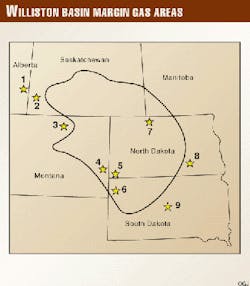Any company that wants to explore for domestic natural gas should consider the Williston basin.
Although the Williston is not usually regarded as a gas basin, economic production of shallow, nonassociated gas from Cretaceous rocks exists around the margins of the basin (Fig. 1, Table 1).
On the northwestern margin, extensive development has resulted in reserve estimates in the range of trillions of cubic feet.
On the southwestern margin, more limited development of local sweet spots has confirmed the resource, but reserves appear to be not as large.
On the eastern margin, areas of historical production and local consumption are undeveloped and virtually unexplored using modern technology.
These three clusters of production share common attributes that are the hallmarks of a new play concept.
Basin margin gas play
Areas of natural gas production around the Williston basin margin have four main elements that constitute the basis for an exploration strategy (Fig. 2):
- Shallow depths (generally less than 3,000 ft) on the basin margin;
- Historic production at the turn of the century;
- Structural traps that include local folds and regional fracture systems; and
- Association with ground water flow systems.
In contrast with basin center gas, basin margin gas is mainly biogenic rather than thermogenic. It is found with immature source rocks at shallow depths. Basin margin methane may locally have smaller amounts of higher hydrocarbons, which suggests that some vertical and lateral migration has occurred. Isotopic compositions and nitrogen fractions are consistent with transport by ground water.
In contrast with the concept of "continuous-type" gas accumulations in unconventional reservoirs, basin margin gas is often trapped in specific geologic structures. Although initial production in a basin margin area tends to be from a local anticline, subsequent development on the flanks of the structure usually follows regional fracture systems. In addition, basin margin production comes from unconventional reservoirs that surround and encase local sweet spots of conventional reservoirs.
For basin margin gas production around the Williston basin, reserve estimates are fairly low at around 1-2 bcf/sq mile. However, large areas of production result in large total reserves. Similarly, initial flow rates in individual wells tend to be small-on the order of 100 Mcfd without stimulation. However, modern completion techniques greatly improve flow rates, and the wells generally have very long production lives.
Northwestern basin margin
The three main areas on the northwestern margin of Williston basin (Nos. 1, 2, and 3, Fig. 1 and Table 1) include large fields that have been on production since early in the 20th century and have, in addition, been exploited by modern development and drilling technologies.
Reservoir rocks on the northwestern margin are mainly low-permeability, interbedded fine-grained sandstone, siltstone, and shale. In addition, discrete bodies of relatively clean sandstone provide local sweet spots. On the US side of the border in north-central Montana, Bowdoin Dome has long been an important shallow gas field with ultimate recoverable reserves estimated to be 475 bcf.1 In Canada, the southeast Alberta gas system is a world-class accumulation with recoverable reserves estimated to be more than 17 tcf.2 The southeast Alberta system and especially the Suffield block and Medicine Hat field have provided analogies for explaining production in other areas.
During the 1970s studies conducted by the US Geological Survey and funded by the US Department of Energy characterized biogenic gas accumulations in the Cretaceous rocks of the northern Great Plains.3 The work was based on the extensive Canadian shallow gas production. Reservoirs in the US were described in nonmarine, transitional, and shallow marine shelf clastic rocks and in chalks.
Although paleotectonic controls on deposition and erosion of source beds, reservoir rocks, and seals were recognized, the importance of structural traps created by post-depositional deformation and of hydrodynamic transport and trapping were not generally recognized.
The USGS conducted more studies of the gas accumulations on the northwestern margin of Williston basin during the 1990s.4 These new investigations have emphasized the importance of structural traps and have included geochemical studies that point to the importance of ground water in the generation and movement of biogenic gas. Hydrologic modeling and techniques of well log interpretation are also pieces of these efforts to characterize shallow gas production on the northwestern margin.
SW basin margin
Cedar Creek anticline (No. 4, Fig. 1 and Table 1) in eastern Montana is the largest gas field on the southwestern basin margin. Initial production was from conventional reservoirs in sweet spots of clean sandstone. More than 140 bcf of gas was produced, and many of these shallow wells have been converted to storage.5
More recently, low-permeability unconventional reservoirs are being developed with the aid of modern logging technology and new completion techniques.6 Little Missouri field (No. 5, Fig. 1 and Table 1) also is producing from unconventional reservoirs on a small anticline.
Both Cedar Creek and Little Missouri fields are located in regional lineament zones, appear to include fractured reservoirs, and have evidence of hydrodynamic trap components. These three aspects are also well illustrated by the gas fields in northwestern South Dakota (No. 6, Fig. 1 and Table 1 ).
West Short Pine Hills field and Cady Creek field are found on anticlines within a regional lineament zone mapped on satellite images (Figs. 3, 4). The main area of production in West Short Pine Hills field is on the eastern, gently-dipping limb of the anticline. Groundwater flow over the fold crest and down the east limb would produce this displaced production pattern in the conventional reservoirs of West Short Pine Hills field.
Cady Creek field produces from less permeable rocks, and groundwater flow is less significant. Consequently, production is centered more directly over the fold axis. Contours (Fig. 4) show values of cumulative production divided by total days of production to normalize well histories; the resulting Mcfd is not an observed daily rate but rather is a computed average that characterizes total production.
In West Short Pine Hills field, contours are elongate north-south and are bounded by specific linear features visible on satellite images. In addition, fractures measured in outcrops of resistant Tertiary sandstone trend north-south, parallel with the elongate production contours.
Eastern basin margin
Three widely-separated areas on the eastern margin (Nos. 7, 8, 9 on Fig. 1 and Table 1) display the characteristics of a basin margin play concept. In all three areas: gas produced at the turn of the century was consumed by local municipalities; gas was associated with artesian ground water systems; and production patterns follow structural trends visible on satellite images.
Historic production associated with artesian conditions is well illustrated by the pre-World War I photo (Fig. 5) of a blowing well bore located in the Souris River area of North Dakota.
Pierre gas field (No. 9, Fig. 1 and Table 1) was the largest and most extensively developed of the three eastern margin areas. The field provided the capital city of South Dakota with municipal gas for several decades in the early 1900s. As artesian pressures declined with extensive ground water withdrawal, gas production was reduced.
It is possible that the modified flow patterns caused the hydrodynamic trap to be shifted away from the existing well bores. Part of Pierre gas field was located on a large anticline bounded by lineament zones mapped on satellite images (Fig. 6). The main production area near the city of Pierre was situated on the margin of this fold in the down-flow direction of water movement.
Other basin margin plays
Basin margin gas accumulations exist in other basins in a variety of reservoirs.
On the northeastern margin of the Denver basin, biogenic gas is produced from chalks in the Cretaceous Niobrara formation. More than a dozen small Niobrara fields are located on small, low-relief closures in northeastern Colorado, southwestern Nebraska, and northwestern Kansas.7
On the northeastern margin of the Powder River basin, coalbed methane is produced from Tertiary sandstones in the Fort Union formation. This type of coalbed methane production in northeastern Wyoming depends heavily on groundwater flow systems associated with localized structures.8
On the northern margin of the Michigan basin, shallow biogenic gas is generated in the Devonian Antrim shale by relatively recent microbial methanogenesis associated with groundwater movement; similar conditions are recognized on the margins of the Illinois basin in the Devonian New Albany shale.9
Several world-class gas accumulations have attributes of the basin margin play concept.
Shallow gas is produced from a variety of Permian reservoirs on the western margin of the Hugoton embayment in southwestern Kansas. The mix of biogenic and thermogenic gas is trapped in a complex manner that includes hydrodynamic, stratigraphic, and structural components.10
On the northern margin of the West Siberian basin, a mix of biogenic and thermogenic gas is produced from Cretaceous clastic reservoirs. Long-distance transport on local anticlines has recently been described for this huge gas province.11
Conclusions
The Williston basin is under-explored for natural gas, and some of the best potential is along the shallow margins of the basin.
This play is ideal for small independents because it is so cheap to drill the shallow wells and because there is relatively little competition. It's also of interest to large independents trying to establish a domestic gas position. The infrastructure that is already in place has been fairly adequate and is currently evolving rapidly in response to expanding opportunities.
The Williston basin, unlike the crowded and over-developed gas basins of the Rocky Mountains and western US, still has readily accessible and undeveloped natural gas reserves.
Acknowledgments
This report benefited greatly from reviews and discussions provided by Jim Menel* of Burlington Resources and by Dave Fischer, an exploration geologist.
References
- Rice, D.D., Nydegger, G.L., and Brown, C.A., "Bowdoin field-USA, Bowdoin dome, Williston basin," in "Structural traps III-tectonic fold and fault traps," Beaumont, E.A., and Foster, N.H., eds., AAPG Treatise of Petroleum Geology, 1990, pp. 337-355.
- Warren, A., "Southeastern Alberta shallow gas pools-reserves and performance data," Alberta Energy Resources Conservation Board, 1985, 18 p.
- Rice, D.D., and Shurr, G.W., "Shallow, low-permeability reservoirs of Northern Great Plains-assessment of their natural gas resources," AAPG Bull., Vol. 64, 1980, pp. 969-987.
- Ridgley, J.L., Hester, T.C., Condon, S.M., Anna, L.O., Rowan, E.L., Cook, T., and Lillis, P.G., "Re-evaluation of the shallow biogenic gas accumulation, Northern Great Plains, USA-Is the similar gas accumulation in southeastern Alberta and southwestern Saskatchewan a good analog?," in "Summary of investigations 1999," Vol. 1, Saskatchewan Geological Survey, Saskatchewan Energy and Mines Miscellaneous Report 99-4.1, 1999, pp. 64-78.
- Clement, J.H., "Cedar Creek-a significant paleotectonic feature of the Williston basin," in "Williston basin-anatomy of a cratonic oil province," Longman, M.W., ed., Rocky Mountain Association of Geologists Symposium, 1986, pp. 323-353.
- Green, T.W., Besler, M.R., and Zander, D.M., "Multistage fracture simulations are making better wells along Cedar Creek," Society of Petroleum Engineers Reprint 38374, 1997, 6 p.
- Pollastro, R.M., and Scholle, P.A., "Exploration and development of hydrocarbons from low-permeability chalk-An example from the Upper Cretaceous Niobrara formation, Rocky Mountain region," in "Geology of tight gas reservoirs," Spencer, C.W., and Mast, R.F., eds., AAPG Studies in Geology No. 24, 1986, pp. 129-141.
- Montgomery, S.L., "Powder River basin, Wyoming: an expanding coalbed methane play," AAPG Bull., Vol. 83, 1999, pp. 1,207-22.
- Martini, A.M., Budai, J.M., Walter, L.M., and Schoell, M., "Microbial generation of economic accumulations of methane within a shallow organic-rich shale," Nature, Vol. 383, 1996, pp. 155-158.
- Olson, T.M., Babcock, J.A., Prasad, K.V.K., Bouthton, S.D., Wagner, P.D., Franklin, M.H., and Thompson, K.A., "Reservoir characterization of the giant Hugoton gas field, Kansas," AAPG Bull., Vol. 81, 1997, pp. 1,785-1,803.
- Littke, B., Cramer, B., Gerling, P., Lopatin, N.V., Poelchau, H.S., Schaefer, R.G., and Welte, D.H., "Gas generation and accumulation in the West Siberian basin," AAPG Bull., Vol. 83, 1999, pp. 1,642-65.
Bibliography
Suffield Evaluation Committee, "Final report relating to evaluation of gas resources of the Suffield Block," Alberta Mines and Minerals, 1972, 31 p.
Gilboy, C.F., "Aspects of regional geologic framework of low-permeability shallow gas reservoirs in Upper Cretaceous strata, southwestern Saskatchewan," in "Summary of investigations 1987," Saskatchewan Geological Survey, Saskatchewan Energy and Mines Misc. Report 87-4, 1987, pp. 199-213.
Hoglund, R.V., "Cedar Creek field," in "Energy resources of Montana," Montana Geological Society 22nd annual publication, 1975, p. 59.
Shurr, G.W., "Shallow gas play around the margins of the Williston basin," in Eighth international Williston basin symposium, Christopher, J.E., Gilboy, G.F., Paterson, D.F., and Bends, S.L., eds., Saskatchewan Geological Society Special Publication No. 13, 1998, pp. 129-139.
Anderson, S.B., and Eastwood, W.P., "Natural gas in North Dakota," in "Natural gases of North America," AAPG Memoir 9, Vol. 2, 1968, pp. 1,304-26.
Schoon, R.A., "Geology and hydrology of the Dakota formation in South Dakota," South Dakota Geological Survey Report of Investigations 104, 1971, 55p.
The Author
George Shurr is co-owner of GeoShurr Resources LLC, devoted to shallow gas exploration in the US northern Great Plains. He recently took early retirement after teaching geology for 30 years at St. Cloud State University in Minnesota. During those years he also did part-time consulting and worked for the US Geological Survey and South Dakota Geological Survey. He holds a PhD degreee in geology from the University of Montana, an MS degree in geology from Northwestern University, and a BA degree in geology and mathematics from the University of South Dakota. E-mail: [email protected]










